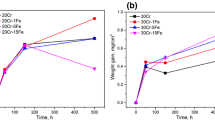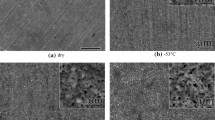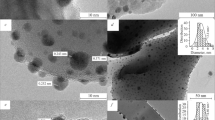Abstract
A study has been made of the effects of an intermediate, isothermal annealing treatment in argon on the oxidation kinetics of copper and nickel in 1 atm oxygen at 800 and 1100°C, respectively, using a semiautomatic microbalance. Changes in scale morphology and composition have been investigated using various physical techniques. The outer CuO layer formed on copper during oxidation dissociates very rapidly on annealing to give CU2O and oxygen since the partial pressure of oxygen in the gas is below the dissociation pressure of CuO but above that of Cu2O at 800°C. The CuO layer is quickly re-formed on reoxidation in oxygen. There are relatively few other changes in the oxide morphologies of either metal during annealing, although the small grains present in the scale adjacent to the metal after oxidation are able to grow. During reoxidation both metals show a reduction in oxidation rate constant because of the decrease in total cation vacancy concentration in the scale and the reduced cation vacancy gradient across the scale brought about by the reduction in oxygen partial pressure at the oxide-gas interface during annealing. The reoxidation rate constants following annealing approach those recorded prior to annealing as the equilibrium cation vacancy levels in the scales are reestablished in the oxidizing environment. Rosenberg's method for analysis of the kinetics of reoxidation has enabled the equilibrium concentrations and diffusion coefficients of cation vacancies in CU2O and NiO during oxidation in 1 atm oxygen at the appropriate temperatures to be estimated approximately. These show reasonable agreement with literature values.
Similar content being viewed by others
References
A. J. Rosenburg,J. Electwchem. Soc. 107, 795 (1960).
E. Fryt, S. Mrowec, and T. Walec,Oxid. Met. 7, 117 (1973).
E. Fryt,Oxid. Met. 10, 311 (1976).
E. Fryt,Oxid. Met. 12, 139 (1978).
W. B. Sharp and D. Mortimer,J. Scient. Inst. (Ser. 2)1, 843 (1968).
F. Maak and C. M. Sellars,J. Scient. Instrun. 42, 900 (1965).
F. H. Stott and G. C. Wood,Corros. Sci. 19, 961 (1979).
F. H. Stott, Ph.D. thesis, University of Manchester (1970).
R. L. Levin and J. B. Wagner, Jr.,J. Electrochem. Soc. 108, 954 (1961).
T. Yamashina and T. Nagamatsuya,J. Electrochem. Soc. 111, 249 (1064).
J. L. Meijering and M. L. Verheyke,Acta Metall. 7, 331 (1959).
F. N. Rhines and R. G. Connell, Jr.,J. Electrochem. Soc. 124, 1122 (1977).
V. I. Arkharov, S. I. Ivanovskoya, and A. S. Krowonosova,Fiz. Metal. Metalloved,22, 884 (1966).
J. S. Van der Broek and J. L. Meijering,Acta Metall. 16, 375 (1968).
A. Atkinson, R. I. Taylor, and P. D. Goode,Oxid. Met. in press.
A. Bruckman,Corros. Sci. 7, 51 (1967).
F. N. Rhines and J. S. Wolf,Metall. Trans. 1, 1701 (1970).
R. L. Pastorek and R. A. Rapp,Trans. Am. Inst. Min. Metall. Pet. Eng. 245, 1711 (1969).
C. B. Alcock and P. B. Brown,Met. Sci. J. 3, 116 (1969).
Y. D. Tretyakov and R. A. Rapp,Trans. Am. Inst. Min. Metall. Pet. Eng. 245, 1235 (1969).
M. O'Keefe and W. J. Moore,J. Chem. Phys. 36, 3009 (1962).
C. Wagner and H. Hammen,Z. Phys. Chem. B40, 197 (1938).
S. Mrowec, A. Stoklosa, and K. Godlewski,Bull. Acad. Polon. Sci., Ser. Sci. Chim. 22, 47 (1974).
K. Godlewski, S. Mrowec, and A. Stoklosa,Bull. Acad. Polon. Sci, Ser. Sci. Chim. 22, 55 (1974).
W. J. Moore and B. Selikson,J. Chem. Phys. 19, 1539 (1951).
J. B. Price and J. B. Wagner, Jr.,Z. Phys. Chem. 49, 257 (1966).
N. G. Eror and J. B. Wagner, Jr.Phys. Status. Solidi 35, 641 (1969).
R. Uno,J. Phys. Soc. Jpn. 22, 1502 (1967).
G. H. Meier and R. A. Rapp,Z. Phys. Chem. 74, 168 (1971).
C. M. Osborn and R. W. Vest,J. Phys. Chem. Solids. 32, 1331 (1971).
J. Christain and W. Gilbreath,Oxid. Met. 9, 1 (1975).
Y. D. Tretyakov, V. F. Komarov, N. A. Prosvirina, and I. B. Kutsenok,J. Solid State Chem. 5, 157 (1972).
M. Yoshimura, A. Reviolevschi, and J. Castaing,J. Mater. Sci. 11, 384 (1976).
Author information
Authors and Affiliations
Rights and permissions
About this article
Cite this article
Wood, G.C., Stott, F.H. The influence of an intermediate annealing treatment on the oxidation of copper and nickel. Oxid Met 14, 187–205 (1980). https://doi.org/10.1007/BF00604563
Received:
Issue Date:
DOI: https://doi.org/10.1007/BF00604563




